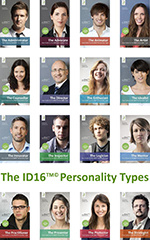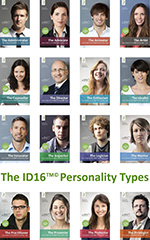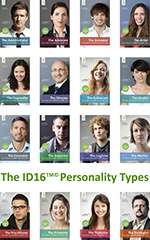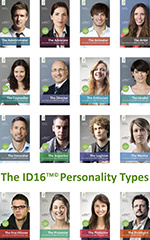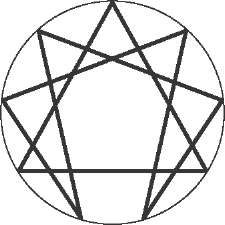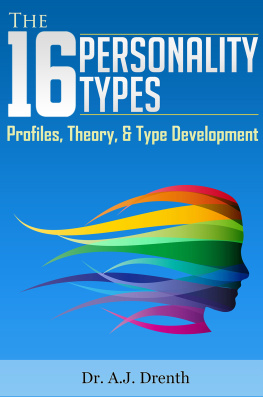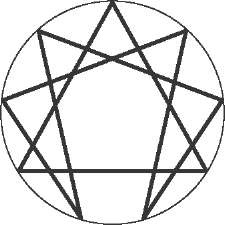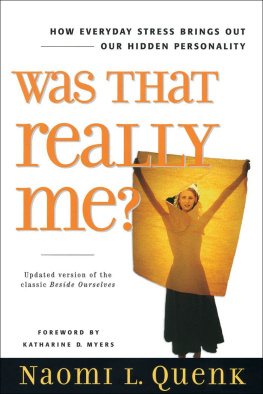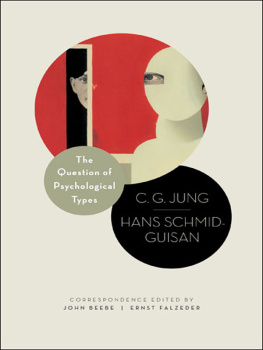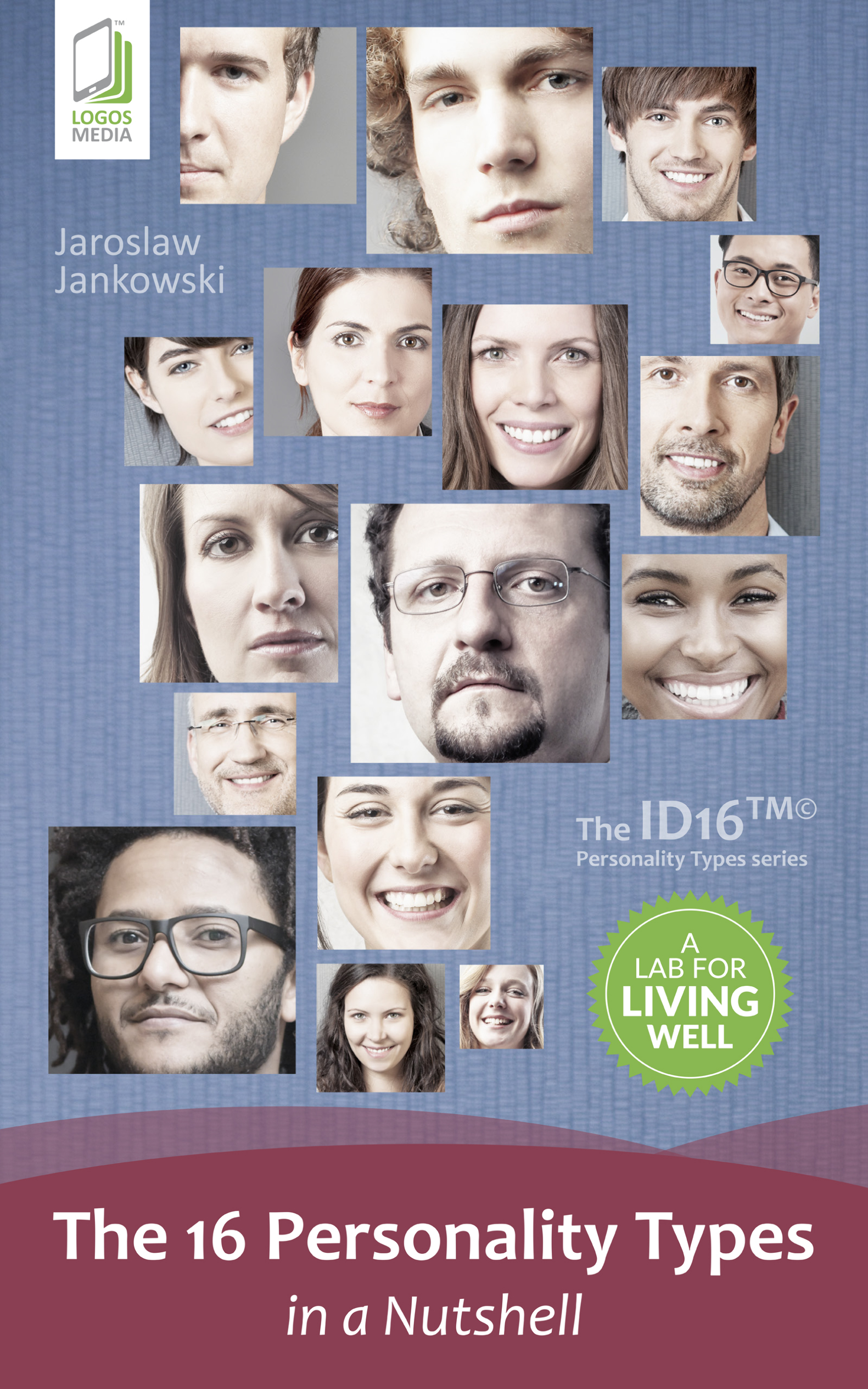
JAROSLAW JANKOWSKI
M.Ed., EMBA
The 16 Personality Types
in a Nutshell
The ID16TM Personality Types series

This is a book which can help you exploit your potential more fully, build healthy relationships with other people and make the right decisions about your education and career. However, it should not be considered to be a substitute for expert physiological or psychiatric consultation. Neither the author nor the publisher accept any responsibility whatsoever for any detrimental effects which may result from the inappropriate use of this book.
ID16TM is an independent typology developed by Polish educator and manager Jaroslaw Jankowski and grounded in Carl Gustav Jungs theory. It should not be confused with the personality typologies and tests proposed by other authors or offered by other institutions.
Original title: 16 typw osobowoci w piguce
Translated from the Polish by Caryl Swift
Proof reading: Lacrosse | experts in translation
Layout editing by Zbigniew Szalbot
Cover photographs by Shutterstock
Published by LOGOS MEDIA
Jaroslaw Jankowski 2016
EPUB: ISBN 978-83-7981-102-1
MOBI: ISBN 978-83-7981-103-8

An Author Campaign Facilitated by ALLi.
Preface
Meet the self-sufficient and brilliant strategist, the constructive and responsive mentor and the warm and optimistic counsellor. Meet the artist, the logician, the enthusiast and the presenter... Discover what makes each personality type distinctive. Then try matching them to your nearest and dearest, your friends and acquaintances. Will you also manage to identify your own type?
The 16 Personality Types in a Nutshell is an introduction to the ID16TM independent personality typology. More comprehensive information about each of the sixteen personality types can be found in the books published in our with the ID16TM Personality Test!
ID16TM is a personality typology which draws on the theory developed by Carl Gustav Jung. Typologies formulated on the basis of Jungs theory are widely used in teaching, training, coaching and human resource management, as well as in career and relationship counselling. They also form a basis for numerous programmes supporting personal development and improving interpersonal relationships. The majority of global businesses employ Jungian personality tests as a standard tool in their recruitment procedures and vocational development processes.
Bibliography
- Arraj, Tyra & Arraj, James: Tracking the Elusive Human, Volume 1: A Practical Guide to C.G. Jung's Psychological Types, W.H. Sheldon's Body and Temperament Types and Their Integration, Inner Growth Books, 1988
- Arraj, James: Tracking the Elusive Human, Volume 2: An Advanced Guide to the Typological Worlds of C. G. Jung, W.H. Sheldon, Their Integration, and the Biochemical Typology of the Future, Inner Growth Books, 1990
- Berens, Linda V.; Cooper, Sue A.; Ernst, Linda K.; Martin, Charles R.; Myers, Steve; Nardi, Dario; Pearman, Roger R.; Segal, Marci; Smith, Melissa: A. Quick Guide to the 16 Personality Types in Organizations: Understanding Personality Differences in the Workplace, Telos Publications, 2002
- Geier, John G. & Dorothy E. Downey: Energetics of Personality, Aristos Publishing House, 1989
- Hunsaker, Phillip L. & Anthony J. Alessandra: The Art of Managing People, Simon and Schuster, 1986
- Jung, Carl Gustav: Psychological Types (The Collected Works of C. G. Jung, Vol. 6), Princeton University Press, 1976
- Kise, Jane A. G.; Stark, David & Krebs Hirsch, Sandra: LifeKeys: Discover Who You Are, Bethany House, 2005
- Kroeger, Otto & Thuesen, Janet: Type Talk or How to Determine Your Personality Type and Change Your Life, Delacorte Press, 1988
- Lawrence, Gordon: People Types and Tiger Stripes, Center for Applications of Psychological Type, 1993
- Lawrence, Gordon: Looking at Type and Learning Styles, Center for Applications of Psychological Type, 1997
- Maddi, Salvatore R.: Personality Theories: A Comparative Analysis, Waveland, 2001
- Martin, Charles R.: Looking at Type: The Fundamentals Using Psychological Type To Understand and Appreciate Ourselves and Others, Center for Applications of Psychological Type, 2001
- Meier C.A.: Personality: The Individuation Process in the Light of C. G. Jung's Typology, Daimon Verlag, 2007
- Pearman, Roger R. & Albritton, Sarah: I'm Not Crazy, I'm Just Not You: The Real Meaning of the Sixteen Personality Types, Davies-Black Publishing, 1997
- Segal, Marci: Creativity and Personality Type: Tools for Understanding and Inspiring the Many Voices of Creativity, Telos Publications, 2001
- Sharp, Daryl: Personality Type: Jungs Model of Typology, Inner City Books, 1987
- Spoto, Angelo: Jung's Typology in Perspective, Chiron Publications, 1995
- Tannen, Deborah: You Just Dont Understand, William Morrow and Company, 1990
- Thomas, Jay C. & Segal, Daniel L.: Comprehensive Handbook of Personality and Psychopathology, Personality and Everyday Functioning, Wiley, 2005
- Thomson, Lenore: Personality Type: An Owners Manual, Shambhala, 1998
- Tieger, Paul D. & Barron-Tieger Barbara: Just Your Type: Create the Relationship You've Always Wanted Using the Secrets of Personality Type, Little, Brown and Company, 2000
- Von Franz, Marie-Louise & Hillman, James: Lectures on Jung's Typology, Continuum International Publishing Group, 1971
ID16TM and Jungian Personality Typology
ID16TM numbers among what are referred to as Jungian personality typologies, which draw on the theories developed by Carl Gustav Jung (1875-19161), a Swiss psychiatrist and psychologist and a pioneer of the depth psychology approach.
On the basis of many years of research and observation, Jung came to the conclusion that the differences in peoples attitudes and preferences are far from random. He developed a concept which is highly familiar to us today: the division of people into extroverts and introverts. In addition, he distinguished four personality functions, which form two opposing pairs: sensing-intuition and thinking-feeling. He also established that one function is dominant in each pair. He became convinced that each and every persons dominant functions are fixed and independent of external conditions and that, together, what they form is a personality type.
In 1938, two American psychiatrists, Horace Gray and Joseph Wheelwright, created the first personality test based on Jungs theories. It was designed to make it possible to determine the dominant functions within the three dimensions described by Jung, namely, extraversion-introversion, sensing-intuition and thinking-feeling. That first test became the inspiration for other researchers. In 1942, again in America, Isabel Briggs Myers and Katherine Briggs began using their own personality test, broadening Gray's and Wheelwrights classic, three-dimensional model to include a fourth: judging-perceiving. The majority of subsequent personality typologies and tests drawing on Jung's theories also take that fourth dimension into account. They include the American typology published by David W. Keirsey in 1978 and the personality test developed in the nineteen seventies by Aura Augustinaviit, a Lithuanian psychologist. Over the following decades, other European researchers followed in their footsteps, creating more four-dimensional personality typologies and tests for use in personal coaching and career counselling.
Next page
